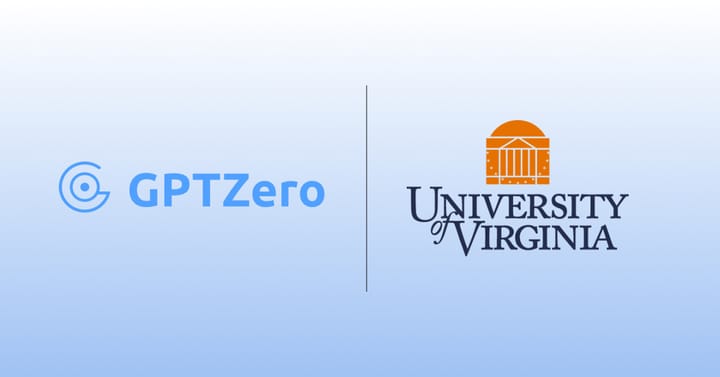GPTZero Partners with University of Virginia School of Education

Since Day 1, GPTZero has been a collaborative effort between our product and the educators who use it.
In many ways, educators are the product managers of our tools, guiding their development and giving feedback on their usability in real-world settings. While we know our product inside and out, it’s the educators who have subject matter expertise in the classroom.
During our time as a company, certain key educators have partnered with us on foundational pieces of the product development process: user research, UX, testing, and feedback. Catherine Brighton is one such educator. She serves on the an academic leadership committee team at the University of Virginia, and oversees academic programs, student affairs, admissions, and enrollment areas of the school.
Alongside Catherine and Stephanie Rowley, Dean of the School of Education, we’ve worked to recruit a community of teachers to trial GPTZero features and help us move the needle. Their insights and feedback will be instrumental in shaping our work, just as we hope to be instrumental in shaping interactions between the educational community and AI.
“Our partnership with GPTZero gives teachers in all stages of their career a voice in shaping new AI tools specifically for the classroom.” said Catherine. “I am most enthusiastic about how this collaboration gives teachers a seat at the table and elevates their insights with the goal of creating effective and accessible AI.”
Elizabeth Adams is another key GPTZero partner; a folklorist and the Dean of the Antelope Valley campus of CSU, Bakersfield. She holds degrees in history, literature, and folklore. Prior to coming to CSUB, she worked for 24 years at California State University, Northridge where she served as Associate Vice President for Undergraduate Studies, Associate Vice President for Student Success, the Associate Dean of the College of Humanities and the Director of the Liberal Studies Program. She has extensive academic administrative experience in the California State University system.
Here’s what that partnership looks like in action.
UVA and GPTZero Partnership

Our methodology centers on active participation and feedback from our “teacher panel.” Educators involved in the trial will participate in a three month engagement
- Fully trial our responsible AI tools – Teachers will use as many of our AI tools as possible in real teaching and assessment scenarios. If they encounter tools they cannot use, we want to know why. Understanding the usability and usefulness of each tool such as Deep Scan, Writing Feedback, and more is crucial.
- Participate in online forums and video calls – Teachers will participate in group discussions and collaborative design sessions to help the GPTZero team improve the tools, based on the teachers’ requirements.
- Student engagement – Where possible, we will garner student and young learner perspectives by asking for their direct feedback. Simply put, there’s no better way to trial how GPTZero will perform in a real classroom, than by engaging students and young learners directly.
Centering Product Management on Educators
Jim Lobdell, co-founder of the Teachers’ Curriculum Institute and a lifelong educational entrepreneur, once wrote: “My co-founder and I knew our initial product would work because we were classroom teachers who essentially codified the curriculum and instructional strategies that worked well with diverse students in our own classrooms. We knew our customers because we were them.” With his own experience and a braintrust of frontline teachers, Lobdell was able to center the educator’s voice during the product development process. Rather than being a technologist first, as many founders are, he upheld the core user needs instead. In other words, Lobdell the product manager and Lobdell the teacher were indistinguishable, working with laser-like focus on delivering the best possible product.
Our educators understand student needs and challenges better than anyone else. Their feedback is invaluable in shaping the tools that are truly effective in educational settings. Not only that, they bring much-needed perspective to the foundational philosophy we use to approach difficult questions around AI: for one, how do we make these tools accessible and democratize access to AI technology?
Being technically sound is one piece of the GPTZero puzzle. Equally important is that as we put new features on the roadmap and deploy them into the universe, they remain genuinely beneficial for teaching and learning. Our partnership with educators like UVA will help us stay aligned to that north star.


